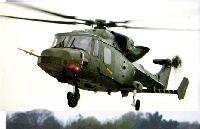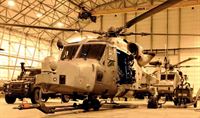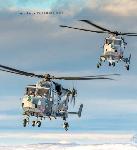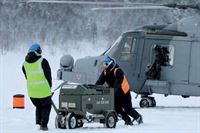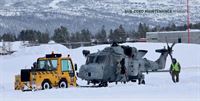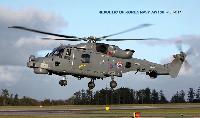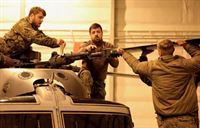
Варианты
- Westland - Lynx - 1971 - Великобритания
- Westland - Super Lynx - 1986 - Великобритания
- Agusta Westland - AW.159 Lynx Wildcat / Future Lynx - 2009 - International
Agusta Westland Super Lynx и Future Lynx
<...>
22 июня 2006 года министерство обороны Великобритании выделило миллиард фунтов стерлингов на программу разработки и испытаний вертолета Future Lynx. Армия и ВМС Великобритании намерены заказать 40 и 30 таких вертолетов, причем заказ может быть увеличен до 45 и 35 машин соответственно. Future Lynx позиционируется как вертолет с классическими динамическими системами, но с новейшим бортовым оборудованием, хотя часть систем планируется заимствовать у вертолета Super Lynx. Фюзеляж будет перепроектирован. С целью увеличения внутреннего объема ему придадут треугольную в сечении форму. В качестве силовой установки рассматриваются два двигателя LHTEC CTS800. Первый полет вертолета Future Lynx запланирован на 2009 год, начало поставок - на 2011 год. Принятие на вооружение армейского варианта ожидается в 2014 году, морской модификации - в 2015-м.
- Описание
Фотографии
-
Air International 2011-07 / I.Harding - Wildcat with Lynx pedigree /Military/
Регистрационный номер: ZZ400 [7] In this April 2010 photograph, T1 No.1 looks very different without the now familiar tailplane.
-
Авиация и Космонавтика 2013-11 / М.Никольский - Вертолетный парк вооруженных сил стран Западной Европы /Вертолетная техника/ (1)
Регистрационный номер: ZZ400 [7] AgustaWestland AW159 Lynx Wildcat/Future Lynx. Разработанный в рамках семейства Super Lynx Series 300, вариант AW159 Lynx Wildcat, ранее известный как Future Lynx, создавался под совместные требования британских Армии и ВМС на новые многоцелевой армейский (Battlefield Light Utility Helicopter) и корабельный (Surface Combatant Maritime Rotorcraft) вертолеты. AW159 - тяжелее, чем предыдущие варианты, его максимальная взлетная масса 6250 кг. Другие важные характеристики - "граненая" хвостовая балка и вертикальные шайбы на стабилизаторе. Планировалось, что 95% вертолета будет новой, а остальные 5% будут заимствоваться с вертолетов AH.Mk 7.
-
Air International 2011-07 / I.Harding - Wildcat with Lynx pedigree /Military/
Регистрационный номер: ZZ400 [7] -
Мировая Авиация 228
Регистрационный номер: ZZ400 [7] 12 ноября 2009г.: прототип вертолета AgustaWestland AW 159, ZZ400, совершил первый полет с аэродрома предприятия "Westland" в Йовиле, Юго-Западная Англия. Lynx Wildcat - многоцелевой вертолет нового поколения, его стартовым заказчиком стали британские ВМС.
Машина, ранее известная как Future Lynx, получила в Британии обозначение Wildcat. Обратите внимание на снижающие ИК-заметность дефлекторы на выхлопных трубах и измененную "фасетчатую" хвостовую балку. -
Air International 2011-07 / I.Harding - Wildcat with Lynx pedigree /Military/
Регистрационный номер: ZZ400 [7] T1 No.1 ZZ400 is primarily used to undertake trials confirming the aircraft's initial flight envelope. Here it is equipped with string markers to aid visualisation of airflow around the airframe. It will soon leave for the US to undertake hot-and-high testing in Colorado.
-
Air International 2011-07 / I.Harding - Wildcat with Lynx pedigree /Military/
Регистрационный номер: ZZ400 [7] Upturned exhausts on the CTS800-4N engines deliver hot efflux into the rotor disc, where it is dissipated for a decrease in the helicopter's IR signature.
-
Air International 2011-11 / News
Регистрационный номер: ZZ400 [7] AW159 Wildcat ZZ400 (TI1) is seen at Canon City, Colorado, during the recent trials in the United States.
-
Air International 2011-07 / I.Harding - Wildcat with Lynx pedigree /Military/
Регистрационный номер: ZZ401 [2] T1 No.2, ZZ401, flew for the first time on October 14, 2010. It is the primary electrical and avionics test bed for systems including DAS and EODS. Wiring fitted to the side of the aircraft is for test instrumentation.
-
Air International 2019-09 / I.Harding, K.Wills - Wildcat /Military/
An 847 NAS Wildcat taxis back to the ramp at Bardufoss having completed a night time sortie during Clockwork 2019.
-
Air International 2024-10 / G.Sands - On the prowl
An asset which packs a significant punch for operational commanders, the AW159 Wildcat significantly enhances the Royal Navy's ISTAR, SAR, maritime interdiction, anti-surface warfare, anti-submarine warfare and logistics support operations, all the time, remaining fully integrated and interoperable with other naval, NATO and coalition assets
-
Air International 2020-12 / Focus: UAV, Rotary, Business, Technology, GA
Регистрационный номер: ZZ395 Wildcat AH1 ZZ395 with the Callen-Lenz Associates UAV
Другие самолёты на фотографии: Callen-Lenz Koios VTOL - Великобритания - 2020
-
Air International 2021-04 / I.Harding - Royal Navy shapeshifters
847 NAS has the pre-eminent specialist aircrew to conduct Joint Fires from the air with highly specialised Forward Air Controllers (Airborne) or FAC(A)s. Some of those precision fires are provided by fixed-wing aircraft, which include fifth-gen fighters such as the F-35 Lightning II
Другие самолёты на фотографии: Lockheed F-35B Lightning II - США - 2008
-
Air International 2012-10 / News
Регистрационный номер: ZZ406 Between September 3 and 7, 2012, AgustaWestland AW159 Lynx Wildcat AH1 ZZ406 (c/n 476) participated in forward arming and refuelling point (FARP) drills on the Salisbury Plain Training Area in Wiltshire. It was the first time the type has operated over the area, the exercise taking place at the Carter FARP with assistance from 6th Regiment Army Air Corps (Volunteers). Wildcat ZZ406 was delivered to RNAS Yeovilton, Somerset, on May 29.
-
Air International 2019-01 / News by countries
Регистрационный номер: ZZ396 Army Air Corps Wildcat AH1 ZZ396 fitted with a side-mounted machine gun.
-
Air International 2021-04 / I.Harding - Royal Navy shapeshifters
847 NAS Wildcat BRH operating at low level during a recent Joint Warrior exercise in Scotland
-
Air International 2016-09 / I.Harding - Operations Across All Boundaries /Military/
The Wildcat AH1 is designed to fulfil a range of roles including intelligence, surveillance and target acquisition, limited troop and material movement, escort, force protection, offensive action and direction of fire and airborne forward air control.
-
Air International 2016-06 / I.Harding - Arctic Wildcat /Military/
An 847 Naval Air Squadron Wildcat AH1 on a familiarisation flight at Bardufoss, Norway.
-
Air International 2011-07 / I.Harding - Wildcat with Lynx pedigree /Military/
Регистрационный номер: ZZ398 [2] The first production vehicle, ZZ398, undertakes its first flight test in late April 2011. It bears 'Army' titles and the colour scheme that will be similar for both the AH and HMA variants.
-
Air International 2019-09 / I.Harding, K.Wills - Wildcat /Military/
Регистрационный номер: ZZ527 [5] -
Air International 2019-05 / K.Wills, I.Harding - Clockwork /Military/
Регистрационный номер: ZZ527 [5] 847 NAS Wildcat transiting to the Setermoen range less than ten minutes' flight time from Bardufoss Air Station. As weather conditions deteriorated and visibility closed in on the range, this aircraft landed in the snow to comply with Clockwork regulations until visibility improved to exceed 1,200m.
-
Air International 2019-09 / I.Harding, K.Wills - Wildcat /Military/
Регистрационный номер: ZZ527 [5] The Arctic is one of the best environments on Earth to train, but is also one of the toughest. Aircrew must remain vigilant at all times. If visibility closes to less than 1,200 metres, aircrew return to base, and when less than 800 metres they must land. For this reason, aircrew carry an emergency Bergen rucksack containing the necessary survival equipment should an emergency landing be required.
-
Air International 2019-09 / I.Harding, K.Wills - Wildcat /Military/
Регистрационный номер: ZZ527 [5] -
Air International 2012-03 / News
Регистрационный номер: ZZ398 [2] Wildcat AH 1 ZZ398 was the first production example of the helicopter to fly, making its maiden flight on April 20, 2011.
-
Air International 2021-04 / I.Harding - Royal Navy shapeshifters
847 NAS deployed four Wildcats to Bardufoss for Exercise Clockwork 2019 during which eleven pilots and five aircrewmen completed ten EQ sorties, the content of which ranged from day navigation and snow landings to tactical night formation sorties operating in two-ships.
847 NAS Wildcat pictured from the air transiting to the Setermoen range, Norway, to work with troops from the US and Netherlands -
Air International 2021-04 / I.Harding - Royal Navy shapeshifters
Unique formation of five 845 NAS Commando Merlin HC4 and three 847 NAS Wildcat BRH, pictured during a recent exercise
Другие самолёты на фотографии: Agusta Westland AW.101 / EH-101 Merlin - International - 1987
-
Air International 2021-04 / I.Harding - Royal Navy shapeshifters
Confined landing training is a vital skill that is practised regularly
-
Air International 2016-06 / I.Harding - Arctic Wildcat /Military/
Регистрационный номер: ZZ388 [2] Wildcat AH1 ZZ388 lifts an underslung load with support from the Mobile Air Operations Team at Bardufoss.
-
Air International 2019-09 / I.Harding, K.Wills - Wildcat /Military/
The Arctic is a tough environment to work in. Degraded vision operations during exercise Clockwork require high levels of team work as demonstrated here.
-
Air International 2019-11 / I.Harding, K.Wills - Sub-zero maintenance /Military/
Moving a generator on the flight line makes for tough work at -15°C.
-
Air International 2019-09 / I.Harding, K.Wills - Wildcat /Military/
Регистрационный номер: ZZ384 Wildcats completed over 260 flight hours during this year's Clockwork exercise which is an impressive number given the sub-zero ambient temperatures, heavy snow fall and recirculation of snow encountered.
-
Air International 2019-11 / I.Harding, K.Wills - Sub-zero maintenance /Military/
Регистрационный номер: ZZ527 [5] This towing tug looks powerful but does not look geared for such snowy conditions.
-
Air International 2019-05 / K.Wills, I.Harding - Clockwork /Military/
Despite heavy snow, 847 NAS aircrew including the squadron CO, prepare their Wildcat AH1 ahead of a next live firing mission at Setermoen range. RUBB hangars which house the deployed helicopters are seen in the background.
-
Air International 2016-06 / I.Harding - Arctic Wildcat /Military/
Регистрационный номер: ZZ388 [2] -
Air International 2019-09 / I.Harding, K.Wills - Wildcat /Military/
Maintenance preparation includes raising the nose wheel to enable Wildcats to operate in deep snow. The struts include a fixed pressure and nitrogen charge to ensure the aircraft sits at a fixed height.
-
Air International 2016-06 / I.Harding - Arctic Wildcat /Military/
A Wildcat AH1 being loaded into an RAF C-17A Globemaster III for transportation to the UK.
Другие самолёты на фотографии: McDonnell Douglas C-17A Globemaster III - США - 1991
-
Air International 2022-06 / T.Fish - Active and alert
A British Army Air Corps Wildcat AH1 helicopter with a mock-up of a Seaspray 7500E V2 AESA radar after completing trials on Salisbury Plain to prove its GMTI and SAR modes in locating ground targets. The Wildcat is already fitted with earlier variants of the Seaspray radar and could benefit from upgraded capabilities
-
Air International 2011-01 / News
Регистрационный номер: ZZ402 [4] AgustaWestland AW159 Wildcat ZZ402 (TI3, c/n 464) completed its maiden flight at Yeovil in Somerset on November 19, 2010. A range of general handling checks were undertaken during the flight, without any unforeseen occurrences. The helicopter is the last Wildcat to fly that will participate in the 600-hour test programme. TI3's main tasks include undertaking load survey tests and naval development, and incorporate ship helicopter operating limit trials. On November 19 all three of the trials fleet were airborne at the same time.
-
Мировая Авиация 145
Регистрационный номер: ZZ402 [4] Максимальная взлетная масса Lynx AW159 Wildcat (на снимке третий опытный вертолет) увеличена до 6250 кг. Предполагается, что серийные Wildcat будут нести двухцветный серый пятнистый камуфляж.
-
Air International 2011-10 / News
Регистрационный номер: ZZ402 [4] Lynx Wildcat ZZ402 is seen on August 2, 2011 carrying two simulated FASGW 'heavy' weapons on both the port and starboard outboard stations, while the inboard port side has a simulated 'light' weapon attached. The in-board starboard position has a box-like 'aero-dummy' box attached as a counter balance.
-
Air International 2019-10 / Airscene
Регистрационный номер: ZZ513 Photographed in the second half of August 2019, Wildcat HMA2 ZZ513 conducted flight testing with two inert Sea Venom missiles on each wing, followed by a mixed configuration of Sea Venom and Martlet missiles
-
Авиация и Время 2010-04 / А.Ларионов - Фарнборо-2010
Регистрационный номер: ZZ401 [2] Новейший морской вертолет Аугуста Вестланд AW-159 "Линкс Вайлдкэт"
-
Air International 2013-10 / News
Регистрационный номер: ZZ413 AgustaWestland AW159 Wildcat HMA2 ZZ413 (c/n 483) alongside a Merlin HM2 at RNAS Culdrose, Cornwall, for the recent radar trials.
Другие самолёты на фотографии: Agusta Westland AW.101 / EH-101 Merlin - International - 1987
-
Air International 2017-02 / I.Harding - A New Era /Military/
Регистрационный номер: ZZ533 The aim is to establish 16 Wildcat HMA2 flights by May 2017; 815 Naval Air Squadron with 12 and 825 NAS with four.
-
Air International 2017-02 / I.Harding - A New Era /Military/
The first deployed flight of the Wildcat HMA2 on a nine-month Atlantic mission provided encouraging signs about the maturity of the aircraft and its stores support.
-
Air International 2011-07 / I.Harding - Wildcat with Lynx pedigree /Military/
Prototype Wildcat T1 No.3 features an under nose radome. It will initially undertake communication systems testing and navigational work, before moving on to gather data for structural integrity tests.
-
Air International 2017-02 / I.Harding - A New Era /Military/
Регистрационный номер: ZZ376 Full operational capability is scheduled for 2018, but initial operating capability was declared in January 2015.
-
Air International 2012-02 / News
Регистрационный номер: ZZ402 [4] Ship helicopter operating limits trials of the AgustaWestland AW159 Wildcat began in January 2012 using TI03 (ZZ402) and the Type 23 frigate HMS Iron Duke (F234) in the English Channel. The helicopter and warship are due to continue the tests throughout January and into early February. Just before Christmas, ZZ402 landed on HMS Iron Duke moored in Portsmouth Naval Base, Hampshire. A Wildcat first landed on a warship when one of the development aircraft alighted on the aviation training vessel RFA Argus off the south coast of England in November.
-
Air International 2017-02 / I.Harding - A New Era /Military/
Регистрационный номер: ZZ397 [3] The current Lynx Wildcat Maritime Force will be become the Wildcat Maritime Force this year; the Lynx HMA8’s out of service date is scheduled for March 31,2017.
-
Air International 2018-09 / ??? - UK Air Power /Military/ (2)
Регистрационный номер: ZZ397 [3] Wildcat HMA2 is one of 28 examples based at Royal Naval Air Station Yeovilton, Somerset. Aircrew rate the type and are especially appreciative of the much reduced level of vibration experienced during operation by comparison to the former Lynx. Aircrew reckon the two stand out systems are the Selex Galileo Seaspray 7400E radar and its L3 Wescam MX-15Di imaging system.
-
Air International 2017-02 / I.Harding - A New Era /Military/
A Wildcat HMA2 photographed flying above Chesil Beach in Dorset.
-
Air International 2015-11
The AW159 is the new twin-engine multi-role, multi-mission, maritime aircraft, with advanced day/night all weather operational capability. In production for the UK Royal Navy, on time and on budget.
-
Air International 2021-10 / A.Drwiega - Going green
The UK military has committed to reducing its carbon footprint through the use of biofuels across a number of its platforms, including the Wildcat helicopter
-
Air International 2024-10 / G.Sands - On the prowl
One of the AW159 Wildcat's roles is fleet protection within a Carrier Strike Group. The missile is a prerequisite for performing this role. In addition to dealing with multiple surface threats, the LMM Martlet allows operators to engage air targets, such as UAVs and other crewed systems, giving the Wildcat greater teeth and the adversary more to consider when the Wildcat is airborne
-
Air International 2025-05 / N.Scrase - Winged and wild
The ultimate aim of the development tests and evaluation process for adding wings to the Wildcat was to operate the maritime attack helicopter in a configuration similar to this proposal, equipped with Thales' 'Martlet' Lightweight Multirole Missiles and Sea Venom sea-skimming anti-ship missiles
-
Air International 2024-06 / R.Scott - Delivering effect
A Martlet-configured Wildcat HMA2 helicopter seen operating from HMS Diamond with an outload of 10 LMM missiles
-
Air International 2024-10 / G.Sands - On the prowl
As an evolution of the highly successful Lynx, the AW159 Wildcat provides new technology and capability to enhance operations across maritime and land domains
-
Air International 2024-10 / G.Sands - On the prowl
Регистрационный номер: ZZ415 Leonardo's AW159 is the latest-generation multi-mission, high-end war-fighting helicopter, delivering unparalleled tactical capability in a compact and robust airframe. As an evolution of the highly successful Lynx helicopter, the AW159 provides new technologies and capabilities, building on customer operational experience gained across land and maritime domains, offering a fifth-generation helicopter that may well be on the verge of securing additional overseas sales
-
Air International 2025-05 / N.Scrase - Winged and wild
Регистрационный номер: ZZ518 [4] Author Nigel Scrase played a key role in developing the Wildcat HMA Mk2's offensive capabilities, focusing on the creation of weapon wings that would enable the carriage of both AGM and ASM missiles without compromising the overall performance of the maritime attack helicopter
-
Air International 2024-03 / P.Kennard - The military light-lift helicopter market past is prologue?
Регистрационный номер: ZZ518 [4] The Royal Navy Wildcat HMA2 has successfully conducted maximum loadout trials with 20 Martlet missiles on a new weapons wing in 2022
-
Air International 2025-05 / N.Scrase - Winged and wild
Регистрационный номер: ZZ397 [3] The Wildcat HMA Mk2 has emerged as one of the most powerful maritime attack helicopters available in the West. In the Indo-Pacific region, HMS Defender's Wildcat is depicted conducting a flypast over HMS Kent, complete with 'Martlet' wings attached. The Wildcat can be configured to carry up to 20 'Martlet' missiles if necessary
-
Air International 2024-03 / P.Kennard - The military light-lift helicopter market past is prologue?
Регистрационный номер: ZZ518 [4] The Royal Navy's Martlet anti-surface guided missile system (which uses the LMM missile as its effector) achieved initial operating capability at the end of October 2021
Introducing the Martel Lightweight Multi-Role Missile (LMM) into service on the Wildcat adds an essential layer of defence to the Royal Navy's Carrier Strike Group. The laser beam-riding missile is guided onto the target by a laser designator on the helicopter -
Air International 2021-12 / Focus: UAV, Rotary, Business, Technology, Space
Регистрационный номер: ZZ518 [4] The 815 NAS Wildcat HMA2 fires the Martlet in the Bay of Bengal
-
Air International 2020-07 / News: Commercial, Military
The Royal Navy revealed the missile was launched "in 0.3 seconds" before "accelerating to one and a half times the speed of sound"
-
Air International 2024-06 / A.Clarke - Eight Questions
A Royal Navy Wildcat HMA2 launches a Martlet lightweight multirole missile (LMM) which has a range of 7km, and a 3kg warhead. Each Wildcat is capable of carrying up to 20 Martlet missiles, which is a significant deterrent in maritime operations.
Since the first successful firings of the Thales 'Martlet' Lightweight Multirole Missile (LMM) from the Wildcat in 2020, the Royal Navy has continued to develop its tactics, techniques, and procedures with successful missile firings against aerial targets. The helicopter has proven its ability to engage land, sea, and air targets. -
Air International 2024-08 / J.Lake - A game of two halves
Регистрационный номер: ZZ378 In July 2015, a Wildcat of 825 Naval Air Squadron (ZZ378) spent two days flying over Falmouth Bay practising torpedo attacks, culminating in the launch of a dummy weapon. Sting Ray had then been in service with the Royal Navy for more than 30 years, carried by frigates and Fleet Air Arm Merlin and Lynx helicopters
-
Air International 2024-10 / G.Sands - On the prowl
Регистрационный номер: ZZ535 The Wildcat's infra-red engine suppression and faceted tail design reduce its thermal and radar signatures. Extensive redundancy in structures, avionics, and critical systems, combined with a proven 30-minute run-dry transmission capability, ensures the highest standards of safety
-
Air International 2025-06 / R.Scott - Lift share
Merlin HC4 and Wildcat HMA2 helicopters operating within the CSG25 task group. Use of the T-150 for ship-to-ship resupply is intended to save operating costs and airframe hours on crewed helicopters and free them up to focus on their primary 'warfighting' roles
Другие самолёты на фотографии: Agusta Westland AW.101 / EH-101 Merlin - International - 1987
-
Air International 2016-12 / I.Harding - Korean Wildcat /Military/
The Republic of Korea Navy plans to deploy its AW 159s from mid-2017 after completing the integration process, which includes pilot training, live weapons firing and naval ship flight trials.
-
Air International 2016-12 / I.Harding - Korean Wildcat /Military/
Republic of Korea Navy QHIs received instructional pilot training at Cornwall Airport, Newquay. This involved approximately 24 hours of left and right seat conversion training, five hours of maintenance test pilot conversion training and ten hours of instructor conversion training.
-
Air International 2024-10 / G.Sands - On the prowl
The flexible avionic architecture and comprehensive suite of available equipment enable the delivery of configurations and capabilities to meet customer mission requirements whilst providing growth capability in both avionics and mission systems, allowing customers to adapt the AW159 to meet their specific operational needs strategically. It's a sales approach that Leonardo is keen to stress to potential customers
-
Air International 2015-05 / News
Two Republic of Korea Navy AgustaWestland Wildcats are currently being test flown at Yeovil, Somerset. Seen here is the second example, 15-0602/ZZ542 during a sortie on February 24, 2015. These are the first of eight on order under a contract signed in 2013.
-
Air International 2016-12 / I.Harding - Korean Wildcat /Military/
The Thales Compact Flash Sonics clipping sonar features an electric reeling machine and an integrated sonobuoy processing system with a VHF receiver able to collect data from both active and passive sonobuoys.
-
Air International 2016-12 / I.Harding - Korean Wildcat /Military/
Two of the Republic of Korea Navy’s first AW159s during trials and development test flying from Leonardo Helicopters’ manufacturing facility in Yeovil, Somerset.
-
Air International 2016-12 / I.Harding - Korean Wildcat /Military/
Two of the AW159s at Jinhae Air Base, South Korea during their July 27, 2016, official acceptance ceremony.
-
Air International 2016-12 / I.Harding - Korean Wildcat /Military/
The first four AW159s for the Republic of Korea Navy. These aircraft are part of the order for eight aircraft placed in 2013.
-
Air International 2018-12 / Airscene
The first of two anti-submarine AW159 Wildcat Mk220 helicopters destined for the Philippine Navy captured completing its initial test flight from Leonardo Helicopters' facility in Yeovil, Somerset, on November 1, 2018. A second flight took place on November 5, 2018. A spokesperson for the Philippines' Department of National Defense announced in January 2018 that its two AW159s will be based on two frigates, which are on order from Hyundai Heavy Industries, without further elaborating on weapons and surveillance systems for security reasons. It is expected that the helicopters will be delivered in early 2019.
-
Air International 2019-06 / Airscene
Philippine Navy AW159 Wildcats departing the Leonardo Helicopters manufacturing facility at Yeovil on April 30, 2019, for the short flight to London Stansted.
-
Air International 2016-12 / I.Harding - Korean Wildcat /Military/
The sonar equipment for the Korean AW159. An integrated sonobuoy processing system collects data from both active and passive sonobuoys.
-
Air International 2024-04 / R.Scott - e-scanning the market
Royal Navy Wildcat HMA2 helicopters are equipped with the Seaspray 7400E radar, a customised variant of the 7000E series
-
Air International 2016-12 / I.Harding - Korean Wildcat /Military/
Spike NLOS is a multipurpose, electro-optical missile containing a video camera in the front that provides a real-time wireless data link for ranges up to 15 miles (25km).
-
Air International 2016-12 / I.Harding - Korean Wildcat /Military/
One of the Korean AW159s on the production line at Yeovil. The Republic of Korea Navy’s order is significant, as it is the first export order for the AW159.
-
Air International 2017-02 / I.Harding - A New Era /Military/
Wildcat is effectively helping reshape maintenance schedules. Serious consideration is being given to whether the Wildcat fleet requires a traditional depth maintenance profile.
-
Air International 2017-02 / I.Harding - A New Era /Military/
A nose-mounted turret houses the L-3 Wescam MX-15Di, which produces high-resolution images for tactical surveillance, long-range target identification, laser target designation and range-finding capability.
-
Air International 2017-02 / I.Harding - A New Era /Military/
Wildcat maintenance packages are blocked together at present into 25, 50,100, 200 and 300 hourly checks, unlike the Lynx, which has flexed maintenance.
-
Air International 2019-11 / I.Harding, K.Wills - Sub-zero maintenance /Military/
Taking some punishment, Sailors and Royal Marines work on a rotor blade with their bare hands.
-
Авиация и Время 2013-01
28 января 2013г. в Великобритании на аэродроме компании Augusta Westland в Йовилле (графство Сомерсет) поднялся в воздух первый серийный вертолет Wildcat HMA Mk 2. построенный для Королевских ВМС Великобритании. Он представляет собой дальнейшее развитие хорошо известного вертолета Lynx. Новая машина должна поступить на вооружение в 2015 г. Всего МО Великобритании заказало 62 "Уаилдкета", из них 28 для ВМС. Вертолет оснащен двумя двигателями Rolls-Royce CTS800-4N (по сравнению с «Линксом» мощность возросла на 38%). В состав оборудования входят обзорная РЛС, оптико-электронная система с ИК и ТВ-камерами, а также лазерная система предупреждения об опасности.
-
Air International 2011-07 / I.Harding - Wildcat with Lynx pedigree /Military/
Wildcat's cockpit features four large multi-function colour displays.
-
Air International 2024-10 / G.Sands - On the prowl
Royal Navy pilots have praised the ease with which the Wildcat can be flown in challenging weather conditions around the ship, which is due to the Digital Automatic Flight Control System (DAFCS) and next-generation avionics on the Wildcat
-
Air International 2017-02 / I.Harding - A New Era /Military/
Crew say flying the Wildcat is a huge step-change from the Lynx. Interfacing between the camera, radar and cockpit displays is completed with a single click.
-
Air International 2024-10 / G.Sands - On the prowl
The Wildcat has been proven to interface seamlessly with uncrewed systems without adding hardware or crew. This provides a combination of systems with greater loiter persistence and flexibility to perform complex maritime operations
-
Air International 2025-05 / N.Scrase - Winged and wild
One-fifth scale Wildcat wind tunnel model being prepared for an aerodynamic test at Leonardo's Yeovil facility
-
Air International 2006-08 / News: Headline, Military, Civil, Accidents, Airshow
The Royal Navy variant of Future Lynx, 70 of which have now been ordered for the UK armed forces.
-
Air International 2007-09 / T.Ripley - Army Wings in the 21st century /Military/
AgustaWestland has secured a contract to supply 40, plus five options, of the Future Lynx to replace the AH.7 and AH.9 variants currently in service. Although this is less than half the current inventory of this type of helicopter, its higher utilisation rate is expected to compensate for fewer airframes.
- Фотографии



